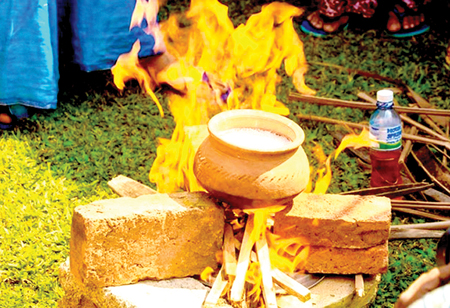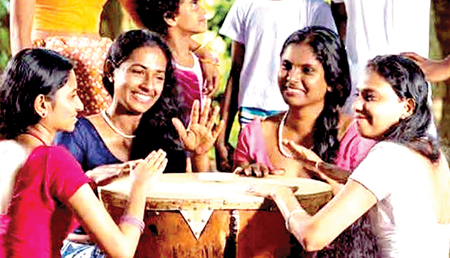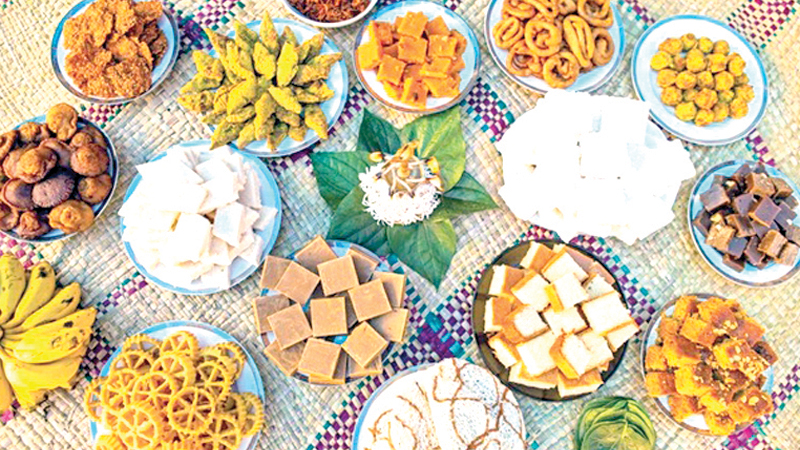Many countries celebrate their new year on January 1, following the Gregorian calendar. But some countries celebrate their new year in different periods of the year. Likewise, Sri Lankans celebrate its New Year on April 13 and 14 following the traditional lunisolar calendar.
A large majority of ethnic groups in Sri Lanka are Sinhalese and Tamils. The Sri Lanka new year is mainly a festival for these ethnic groups and therefore, officially known as Sinhala and Tamil New Year. The other ethnic groups also join with them in celebrating the new year. The Sinhala and Tamil New Year is the only major traditional festival that commonly observed by that largest number of these two communities in the country.

Lighting the hearth and boiling milk
Sri Lanka’s new year is determined by the astrologers and rituals are based on traditions that were practised ancestors. Rituals associated with the New Year begin with bathing on the last day of old year and viewing the moon on the same night.
The Sri Lanka New Year celebration marks the passing of Sun from the Zodiac of Pisces to the Zodiac of Aries. Transition period counts when the Sun begins to cross the astrological border of the House of Pisces and ending when crossing is complete. When the sun reaches the point way midway it signifies the dawn of the New Year.
The period taken for the sun to move from House of Pisces to the House of Aries is regarded as transition period. This period is inauspicious or neutral according to the astrologers. The transition period is 12 hrs. and 48 minutes. It does not take place at a specific time very year. It is determined according to the astrological calculations. The tradition dictates to engage in religious observances at temples and not to attend any other activity including cooking during the transition period.
The Sri Lanka New Year coincides with the end of main agricultural harvest particularly paddy harvest as Sri Lanka is predominantly an agricultural society. It is also the celebration of harvest. Once paddy is harvested and stored, people are free during this period until the next cultivation season which starts in May. Further, they are in a happy mood to celebrate the harvest. The environment is conducive for celebrations. There is greenery everywhere: fresh leaves on trees, flowers in bloom, vegetables and fruits in plenty and song of birds in the air.
Worship the Sun God
In ancient times, this festival was to respect and worship the Sun God for providing good weather for a good harvest. The Sun was God to the primitive societies that occupied earth. The Sun has been the base on which time and seasons were counted upon. This Sun worship was practised in ancient Sri Lanka. This legacy still continues as part of New Year celebrations.
There are a number of important and standard rituals in Sri Lanka New Year celebrations. All rituals are performed to precision at times throughout the country prescribed by the astrologers well ahead of the beginning of the year.
Preparation for New Year begins well ahead of the New Year week. Houses are cleaned, painted and unwanted old items are thrown away. New clothes are bought for everyone to wear on the New Year day and also for gifts to others. Everybody in the country wear new cloths on this day. There are varieties of special sweets for the New Year celebrations. These sweets are made from rice flour which comes from the new harvest. They are made at least a week ahead. This time women folk are busy with preparing these sweets. Apart from the clothes, people particularly the housewife purchases new clay pots for New Year day cooking and boiling milk while children light fire crackers.
Those who are away from the village for employment return to the village to celebrate New Year with the family members and visit relations, elders and friends in the village. During this period, schools also closed for holidays. Boarding school students and university students also return to the families.
A unique feature of the Sri Lankan New Year is the fire crackers. Children really enjoy lighting fire crackers throughout the New Year period. Auspicious times are indicated by the bhikkhus by ringing the temple bell. This tradition was started when everybody in the village does not have their own clocks. However, this tradition continues even today.
Many rituals
There are many rituals that are associated with the Sinhala and Tamil New Year which include; lighting the hearth, consumption of first meal, re-starting work, exchanging money, exchanging food with neighbours and anointing oil. They all perform in an auspicious time.
After the dawn of the New Year, the first task of the year is lighting the hearth according to the auspicious time boiling milk and allow it to overflow. This is a sign of prosperity in the year ahead. The hearth is lit by the housewife facing the designated direction while the other family members young and old gather around.
Before lighting the hearth, the housewife would worship the new pot three times. Subsequently, milk rice is prepared from the harvest obtained from their paddy fields. Milk rice is usually mixed with jaggery. Milk rice is prepared by cooking rice with the coconut milk. It is a form of rice pudding essential for New Year table. This is first meal in the New Year.
Taking the first meal is also made at an auspicious time. The New Year menu comprises milk rice and a number of sweet items. These sweet items include oil cakes, sweetmeats of rice flour and treacle, deep-fried crispy and savoury, made of rice flour and coconut milk called Kokis are among the many other sweet items. New Year table is laid with a number of traditional sweet items, milk rice and bananas.
Consumption of food
Consumption of food also takes place at an auspicious time determined by the astrologer. The head of the family feeds his wife and children adhering to the direction given in the astrology. Once the consumption by the members is over, spouses mutually exchange money using betel leaves. Children show respect to their elders by offering sheaves of betel and elders bless them. This is the time for sons and daughters who are employed or married and living separately to show their gratitude to their parents by giving gifts. The elders in return would give them money and commence the first financial transaction of the New Year.

Beating one-sided open bottom drum while singing new year verses
In some parts of the country, this ritual is different. Family members invite the elite of the village to open the New Year table and do monetary transactions. Soon after this ritual, male folk attend some agricultural work like planting a plant symbolising resumption of work that was stop during the transition period. Children recommence studies by reading and writing. Once all these activities are over, families share a plate of food consisting of the items that are on the table with the neighbours. Neighbours also do the same thing. This is a goodwill gesture that symbolises togetherness. Once a family visits another family, they are also invited to the New Year table.
After all these rituals are over, the families assemble where New Year celebration takes place. New Year festival is organised in every village and every town. This is a big event for everybody to take part and also to enjoy. There are specific outdoor games and fun-filled activities that could be seen during the New Year festival. They may include beating the large one-sided open bottom drum by a group of women while singing lyrical versus (Raban), swings which women and children ride singing special verses, pillow fighting, stride a raised pole, marking the eye on an elephant drawn on a board while blindfolded, the traditional western tug-o-war, in Sri Lankan style, climbing a greasy pole ten metres high to claim a flag, New Year beauty queen contest are a few of them. There are indoor games also played at home with either family members or with neighbours. They include games with sea shells and crab’s eye seeds.
The main meal of the New Year consists of lots of vegetable curries. Cashew nut curry is also among them. It is either lunch or dinner depending on the timing.
Anointing herbal oil
The New Year festivities come to an end with anointing herbal oil. This is also made according to the date and time determined by astrology. This day normally falls after a few days of the New Year day. This is also a unique ritual. Preparation of oil is usually made at the village temple. Coconut oil mixed with extracts of herbs are first blessed by the bhikkhus at the village temple whole night and then distributed to the people. At temples bhikkhus anoint the oil on the devotees’ head and bless them chanting stanza of benediction. The meaning of this is as follows.
May all blessings be upon you
May all the gods protect you
By the power of the Buddha’s
May you always be well.
Alternatively, families bring oil from the temple and anointing is performed by the elder of the family at the auspicious time. Sri Lankans believe that anointing one from head to toe purifies both mind and body. In performing this ritual, either the bhikkhu or elder of the family stands upon leaves, roots and flowers and anoints the oil. After anointing the oil, everybody goes for a bath.
Going to work in the New Year also is at an auspicious time. But with urbanisation, people are engaged in complex economic activities, this is now not observed by the majority of people. There are a number of countries that celebrate the New Year on the same day including Bangladesh, Burma, Cambodia, Laos, Tamil Nadu, Burma and Thailand.
The unique feature of Sinhala and Tamil New Year is all the activities associated with the New Year are practised at the precise time throughout the country as determined by astrologers.
The writer, Senior Lecturer, University of Papua New Guinea Panditha Bandara ([email protected]) is the President of Sri Lanka – Papua New Guinea Friendship Foundation and Consul for Sri Lanka in Papua New Guinea




